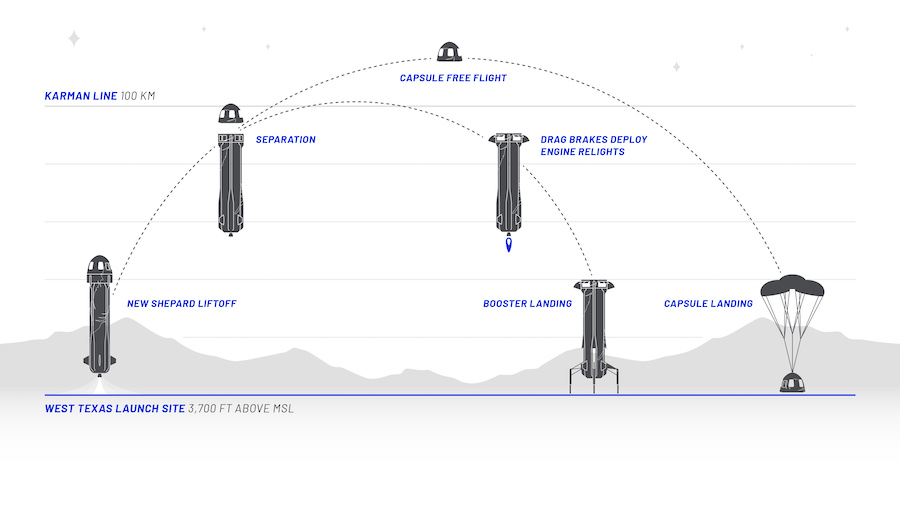Blue Origin’s New Shepard suborbital launcher will loft six passengers, including the rocket’s chief designer, on an up-and-down flight to the edge of space Thursday.
The commercial space company is expected to launch the single-stage New Shepard rocket from West Texas shortly after 9:10 a.m. EDT (1310 GMT; 8:10 a.m. CDT).
The mission will last a little more than 10 minutes from liftoff until touchdown of Blue Origin’s crew capsule, which will return to the company’s sprawling test facility for landing just a couple of miles from the launch pad.
The 60-foot-tall (18-meter) reusable New Shepard rocket will launch six passengers to an altitude just above 62 miles (100 kilometers), the internationally-recognized boundary of space.
The flight, designated NS-20, will be Blue Origin’s fourth launch to haul human passengers to suborbital space, and the 20th flight of a New Shepard rocket since 2015, including experimental test flights to prove out the system before carrying people.
The passengers on the NS-20 mission include George Nield, a longtime proponent of commercial spaceflight, and Gary Lai, a Blue Origin engineer and chief architect of the New Shepard space tourism program.
Nield is the former head of the Federal Aviation Administration’s commercial space division, the regulatory and licensing body for commercial spaceflight operations in the United States. Before his time at the FAA, Nield worked for Orbital Sciences Corp., served as a flight test engineer at the Air Force Flight Test Center, and was manager of the flight integration office for NASA’s space shuttle program.
“I’ve really been interested in space since I was a child,” Nield said in a pre-flight interview tweeted by Blue Origin. “I used to cut out articles in the newspaper about the space camps and the Mercury astronauts.”
Lai will become the third member of the Blue Origin team to fly to space on the New Shepard rocket. The company’s first mission with humans last July carried Blue Origin’s billionaire founder Jeff Bezos and three co-passengers, and a second human flight in October included Audrey Powers, the company’s vice president of New Shepard mission and flight operations, alongside actor William Shatner and two other crewmates.
The third New Shepard human flight Dec. 11 was the first to launch with a crew of six, including former NFL player and TV host Michael Strahan and Laura Shepard Churchley, the daughter of late NASA astronaut Alan Shepard, the first American to fly in space.

“Looking out the window and seeing a black sky and the curvature of the Earth is really going to be special,” Nield said. “To be able to fly with this crew, including Gary Lai, who’s had such a major role in creating New Shepard, is just very special to me.”
In a Blue Origin corporate interview, Lai said he has worked on the New Shepard program “from the very beginning.” He was one of the first 20 Blue Origin employees, joining the company in 2004.
“I’ve been involved in every single aspect of the design and the production of the vehicles,” Lai said.
“This is a once in a lifetime, a once in a career, opportunity to follow a program from start to finish to such a major goal,” Lai said. “So I hope I will feel that it was as meaningful as the amount of time and energy that we’ve put into it.”
Lai replaced comedian Pete Davidson, who Blue Origin originally announced as a passenger on the NS-20 mission. Blue Origin said the Saturday Night Live cast member was “no longer able to join” the mission after a launch delay from March 23.
Marty Allen, another NS-20 crew member, is a turnaround CEO and angel investor from California. Jim Kitchen is a teacher and entrepreneur from North Carolina who has visited all 193 U.N.-recognized countries.
Sharon and Marc Hagle, a Florida couple, round out the NS-20 crew.
Sharon Hagle is founder of SpaceKids Global, a nonprofit aimed at inspiring children to excel in science, technology, engineering, the arts, and mathematics. Her husband, Marc, is president and CEO of the real estate firm Tricor International.

The capsule flying on the NS-20 mission is named “RSS First Step,” with RSS standing for Reusable Spaceship. The rocket is Tail No. 4 in Blue Origin’s fleet.
Powered by a hydrogen-fueled BE-3 engine, the single-stage New Shepard booster will climb through the atmosphere to reach an apogee, or maximum altitude, of more than 328,000 feet, higher than the internationally-recognized boundary of space.
The BE-3 engine will fire for more than two minutes, then the rocket will separate from the crew capsule before coasting to their apogee altitude and beginning their descent back to Earth.
The booster stage will deploy drag brakes, reignite the BE-3 engine, and extend a landing gear before touching down on a landing pad just north of the launch site. The capsule, meanwhile, will unfurl three main parachutes and fire braking rockets to cushion the landing on the desert floor at Blue Origin’s remote West Texas test complex.
Email the author.
Follow Stephen Clark on Twitter: @StephenClark1.
from Spaceflight Now https://ift.tt/ta91lGh
via World Space Info







0 comments:
Post a Comment